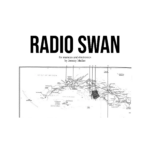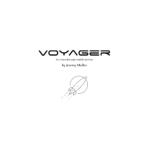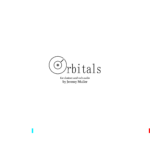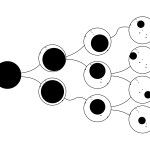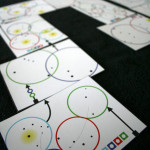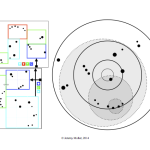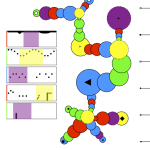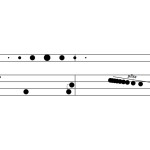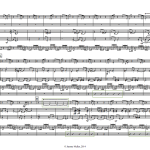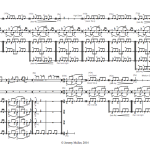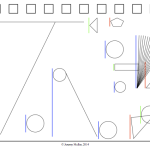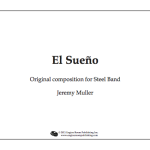Compositions
Below is a list of my completed compositions over the years. I am available for any commissions and/or presentations of my work and I always enjoy collaborating with other musicians with new ideas. Some of these works are available through a particular publisher so check to see if there is link to where you can purchase the work. Otherwise, contact me if you are interested in obtaining and purchasing a score.
WORKS LIST:
Radio Swan (2025) – For maracas and electronics. The piece gets its name from the pirate radio station in which CIA shenanigans used to broadcast propaganda into Cuba in order to foment revolt against Fidel Castro in the early 1960s. In this work I am exploring some of the previous century’s communication technology as an aesthetic for the electronics and live audio interaction. Some of the musical material is taken from the radio broadcasts translated into Morse code. The electronic part is specifically designed to be low fidelity, efficient, and full of digital audio artifacts and glitches. This is both an aesthetic choice as well as a practical choice in that I purposefully want the live electronics to run on a raspberry pi. additionally, this piece is meant to showcase a small setup (something that is rare for percussionists) with an ease in travel, demonstrating a virtuosity in seemingly simple objects. “Radio Swan” can also be a companion piece to Javier Alvarez’s “Temazcal” in that both works are for maracas and audio accompaniment or electronics. My inspiration from “Temazcal” has been to compose an interactive work where the computer manipulates live audio input through the Raspberry Pi.

No Diagonals (2023) – For two indeterminate pitched instruments. This was originally written for Alexandria Smith (trumpet) and Jeff Albert (trombone). No Diagonals is a graphic score that progresses in dimensions further along in the score. It goes up to the 4th dimension with the final row being a variation on a tesseract (a four-dimensional hypercube). If you would like to perform this piece you can download the PDF here: No Diagonals score. If you do perform this please let me know and send me your concert program! email: jeremy [at] jeremymuller [dot] com or Contact page.
Exajoule (2020) – For marimba quartet and mobile devices. Exajoule was written for and premiered by the Heartland Marimba quartet in September of 2021 in Omaha, NE. The score is provided only as a reference to see how the marimbas and phone parts line up. This work is only meant to be synchronized with events (hopefully < 0.5") in what becomes a thick musical texture from phones. The number of staves shown in the phone parts correspond to the number of layers at the given moment. These layers are divided up among the participating mobile devices based on probabilities. Web audio facilitates audience participation by using their own devices, whether a phone, tablet, or even a laptop computer. This piece primarily turns audience devices into speakers so that they are immersed in the musical textures. They simply visit a web site rather than having to download a specialized application – and incidentally avoids having to have a specialized application approved by some monolithic corporate entity. The beauty of web audio is that it is created on a ubiquitous platform, the web browser, which makes it very easy to share your audio application.
Singularity (2019) – For six berimbaus, premiered by Arcomusical in 2021. Singularity uses self-replication as a basis for the all the material generated in this work. The title itself suggests many meanings; a singularity as infinite, undefinable, and simple changes creating complex systems. Or a singularity in which artificial intelligence will irreversibly accelerate beyond human intelligence. These concepts are reflected in this piece where the melodic material takes on a sense of ‘intelligence’ but guided by boundaries. A system or structure developing from a simple idea, something that is ubiquitous in our lives (many biological organisms, environmental systems, and modern electronic devices exhibit this), is another fascinating concept I explored in this work. As the composer, I wanted to experiment with a generative device but still shape it intuitively. I wasn’t interested in creating a system to work on its own, but rather a system I can work with in tandem. Singularity is the growth from this system – trimmed and pruned – into an ensemble for six berimbaus.
Blackwater: the little prince (2020) – For snare drums, mobile devices, and animation, premiered at the 2020 X-fest in Phoenix, AZ. The electronic accompaniment part I created primarily turns the audience’s phones into speakers for a completely immersive experience with omnidirectional sound. In Blackwater, the solo instruments are the two snare drums while the electronic part is an extension of that sound using only filtered or downsampled noise. Blackwater is about the infamous private mercenary army founded by Erik Prince, its war crimes, and how “endless wars” is a business model in the 21st century. The choice of snare drums is because of its long history and association with war – this became a historical choice as well as a timbral choice to represent the brutality of war.
Voyager (ensemble version, 2018) – For ensemble and mobile devices, premiered by ACME (Arizona Contemporary Music Ensemble) for the Music Prisms Festival 2018. The instrumentation is for flute, Bb clarinet, cello, piano, and three percussion. Also called, “The Grand Tour” based on the NASA Jet Propulsion Laboratory poster, which was named for the Voyager missions. This piece, “Voyager,” uses data from each planet – and their moons – the voyager satellites flew by during their missions. Web audio on mobile phones allows for audience participation by using their own devices, whether a phone, tablet, or even a laptop computer. Each participating audience member is a small grain in the overall musical texture that accompanies the ensemble. To enhance the audience’s ambient texture, 3 percussionists are equally spaced surrounding the entire performance space to encapsulate the sound. The concert experience immerses the listener in complete 360-degree sound.
Orbitals (2018) – For clarinet and mobile devices, premiered by Josh Bennett. This work is based on the idea of the electrons in atoms and the probability of finding an electron around the atom’s nucleus. The fascinating concept here is that we can only predict electron behavior through probabilistic models – in other words, you have to use chance, not determinism, to find an electron. This is quite different from our understanding of large bodies (like planets, moons, stars, etc.) orbiting around other large bodies where things are predictable and deterministic. In Orbitals, I loosely explore this idea of using small, probabilistic variations in order to create larger complex sounds (which is a metaphor for the universe I suppose). The audience members participate in the web audio accompaniment on their mobile devices, and as the piece progresses the layers begin to diverge from each other and create very thick textures.
Voyager (2017) – For piano and mobile devices, premiered by Karl Schindler at the Phoenix Experimental Arts Festival. This work is based on the NASA voyager interstellar mission that flew by Jupiter, Saturn, Uranus, Neptune, and continued into interstellar space. Voyager uses web audio to allow audience members to participate with their mobile devices. This piece immerses the listener in an audio-visual experience and connects each person to the musical texture.
Polymers (2015) – For percussion trio and electronics, commissioned by Arc Percussion. This work is in four movements where the players move about the performance space. The musical material is largely based on various types of probability events. Instrumentation includes: conch shells (mvmt 1), skins & woods (mvmt 2), pitched metals (mvmt 3), and triangles (mvmt 4).
Hysteresis (2015) – For vibraphone and sine waves. Hysteresis was inspired by James Tenney’s alluring Critical Band. Hysteresis starts off with a similar idea. Using a sine wave detuned a few hertz – less than about 20 Hz difference – from the vibraphone pitch creates a rhythmic beating. Slowly changing the pitch of this sine wave by 8 Hz or so makes the rhythmic beating either slow down or speed up (depending on if the detuning is getting sharper or flatter). This beating sound comes from the sound waves canceling each other out at certain times while other times reinforcing each other. Hysteresis is published through Bachovich Music and available here.
Omónoia (2015) – For percussion quartet playing snare drums with many different objects and implements. As the companion piece to Agóna, this work is an interpreted graphic score using specific constellations as the musical material. Additionally, the ensemble has to create a map of the score by carefully placing cards in a specific path. This particular ensemble heard in the excerpt below consisted of: Rob Esler, Doug Nottingham, Brett Reed, and Lisa Tolentino.
Agóna (2014) – For four melodic instruments with timbre control. This piece premiered on September 20th, 2014 and was written for the Classical Revolution Phoenix Second Bi-Annual Composition Competition and won the judges’ pick for the concert. The theme was celebrating the 50th anniversary of the Civil Rights Act. For this piece, I developed a system of notation using constellations (only ones listed by Ptolemy) that was readable from any direction. The players lay the cards on a table during the performance that will create the structure of the piece in real-time. Then they perform that structure using their assigned color blocks and specific symbols indicating how to interpret the notes. This particular ensemble consisted of: Kate Mulligan-Ferry (flute), Bill Aikens (oboe), Allyson Wuenschel (viola), and Li Ma (cello).
Sonorant I (2014) – For percussion sextet. This piece was commissioned by the Glendale Community College Percussion Ensemble and premiered on April 30th, 2014. The players surround the audience and their setups consist of either metals, woods, or skins. The score gives musical information in the form of shapes, colors, and proportional dot notation. Players interpret their material by taking influence from adjacent players. The piece follows the idea of a simple algorithm that unfolds as the players interact.
Auricle (2013) – For micro-tonal berimbau and live processing. This piece was written for an amazing percussionist/friend/colleague, Simone Mancuso. This is a revised version of the piece – Auricle 1.1. It features a (better) readable score and selects excerpts in real time. Also I fixed portability issues so all the software is free, open source, and should work on any machine. See this page for more details.
Métier (2013) – Written for University of Arizona’s CrossTalk ensemble and UA Steel. This composition was the second prize winner of the James P. & Shirley J. Obrien Endowment Composition Competition. This piece combines a traditional steel band with an electronic percussion group and the competition was to develop repertoire for this type of collaboration.
Quociente : Laços (2012) – Based on the same piece as Quociente for six berimbaus, I wanted to give myself (and others) a way to perform this work without the need for five other berimbauistas. Since this reduction, I’ve performed this work at many different venues in the Phoenix area including: Phoenix Art Museum, Arizona State University, and the ASU-West Electro-Acoustic festival. This version is for a single berimbau and computer. Other than a few minor changes, this is easily reduced down to a solo work. There are 2, 4, 5, and 6-channel versions available. Contact me for more details. Additionally, this work was included as part of the PASIC 2013 Listening Room in Indianapolis and now has been added to the PASIC Archives.
Quociente (2011) – Premiered in April of 2012 by Greg Beyer and the NIU Bau House in Dekalb, IL. Written for six berimbaus, this work is constructed of linear polyrhythms resolving to their representative intervals. For example, an interval of a perfect 5th is a rhythmic relationship of three to two. In Quociente, this may be heard by two berimbauistas performing a rhythm of 3:2 that lands on a perfect 5th – as the rhythm cycles back around. The piece layers this idea throughout and uses much more complicated rhythmic and intervallic relationships, which equals fun. Read more here.
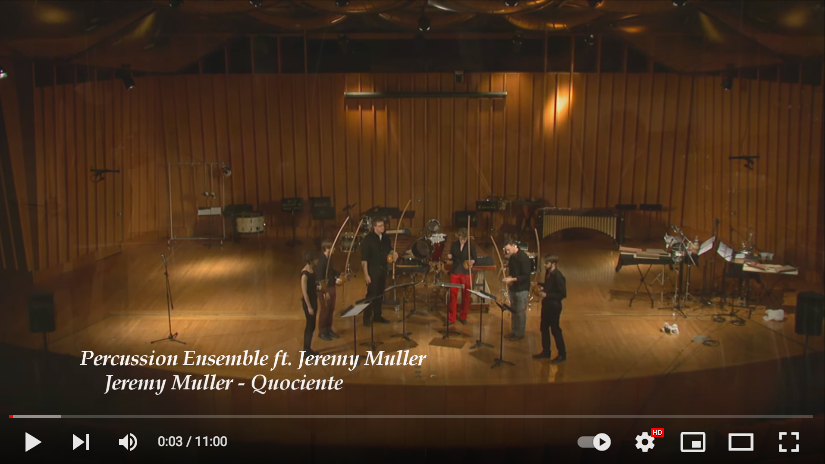
“Quocíente” performed by the NIU Bau House
Music for Botany (2010, published 2014) – Premiered in December of 2011 in Tempe, AZ. It is now published and available from Bachovich Music Publications. Written for maracas, caxixí, and pre-recorded audio, this is an original work of mine and part of a project to place folkloric instruments in a contemporary musical idiom. As the name may imply, it is modeled after Steve Reich’s Music for Pieces of Wood. Read my notes from the score and my doctoral thesis excerpt to understand the relationship to Reich’s work while maintaining musical styles of Venezuela. This work was included as part of the PASIC 2013 Listening Room in Indianapolis and now has been added to the PASIC Archives. It also exists as a solo version and an ensemble version (1 pair of maracas and 4 pairs of caxixí) if you prefer a chamber setting. As requested, I made an explanation video to help understand how to play the caxixí and maraca parts. You can find the video below. If you have any more questions about this piece and/or the techniques required for playing these instruments, please contact me and I’ll do my best to help. Listen below and read more here.
Ionically Charged Harmonics (2006) – This is a graphic score for at least three instruments (3 groups required) and any length of time. Performers must agree on the method of “counting” each page – that’s why the header blocks are left blank. This work grew out of a project I did in a course I took at CCM that Allen Otte was teaching. The course was discussing graphic notation and this is some of the work as a result. The original score was hand-written on graph paper so I’ve been attempting to clean it up in my free time by copying the pages into a nice editor. The horizontal axis represents time and the vertical axis represents timbre (top is bright, bottom is dark). The corners of shapes represent the number of icti while circles only fade in/out. However, the work is still in its early stages and I’ll try to have more on this work as it continues to evolve – which really means I need to sit down and finish writing (drawing) it…
Traveling Music for Quartet, No. 2 (2005) 9’30” – Another three movement piece with similar compositional ideas from Quartet No. 1. The work is for Oboe, Bassoon, Viola, and Cello.
The Road to You (2004, published 2012) – Premiered in February of 2004 in Boone, NC. This arrangement of a delicate Pat Metheny ballad is now published and available from Bachovich Music Publications. It’s arranged for solo vibraphone and completely written out – so for all you non-improvisers, never fear. The arrangement follows a typical A-B-A form with A being the clear statements of the melody. Although this is a completely written-out arrangement, the B section takes on the archetypal improvisatory portion of the work. One of the challenges the performer must overcome is to sustain a chord while highlighting the melody using advanced dampening techniques. But you will find that the vibraphone’s mellow nature is exceptional for illustrating this work.
El Sueño (2004, published 2011) – A recently published and original work for steel band. This tune began many years ago for a small fusion group and now has evolved into a full-blown steel band chart. Contact Engine Room Publishing, Inc. for obtaining the score and parts. El Sueño is a work about the surrealist nature of a dream – toying with expectations. In this case, it is the expectation of what will come next given the particular genre of music. Sometimes a new section is immediately recognized, while other times the music morphs into the new material.
Aurora Borealis (2004) 8’40” – This work is for string orchestra (quartet + double bass) and was inspired by the Polish composer, Wojcieck Kilar’s Orawa.
Traveling Music for Quartet, No. 1 (2003) 8’30” – This three movement piece grew out of a composition assignment I had during my first year in college. The work is for Soprano Saxophone, French Horn, Bassoon, and Double Bass. I originally was experimenting with the timbres of the three wind instruments: brass, single reed, and double reed. But after several years of tweaking and more tweaking, I’ve decided that substituting an oboe for the soprano sax is completely fine with me…
